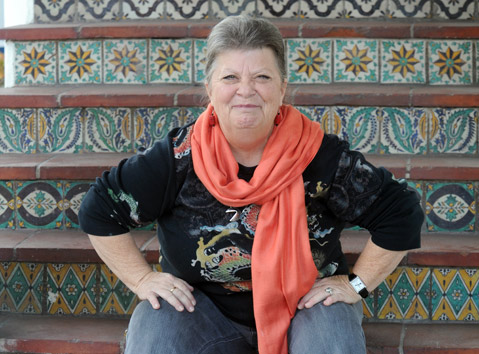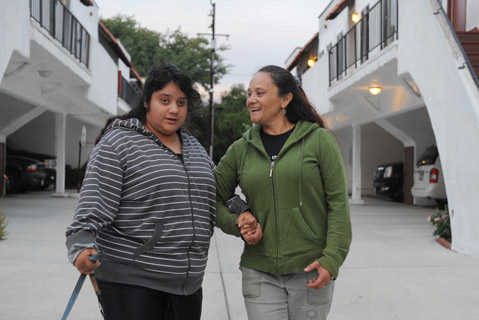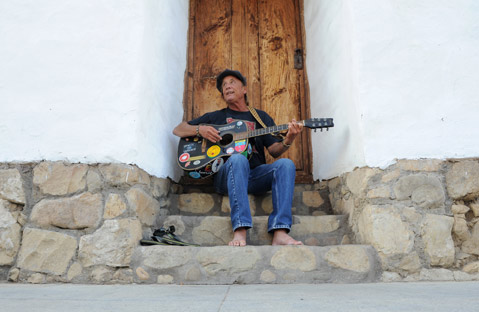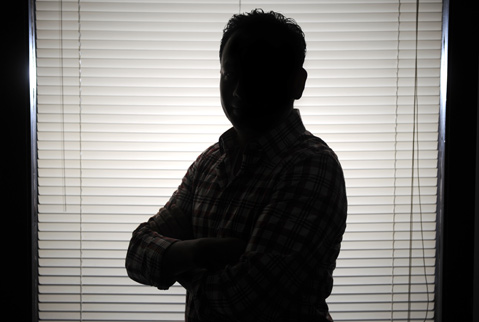Sketches of Survival

Maureen McFadden
I grew up outside Philly, lived in D.C., New York City, on rock ’n’ roll tours for two years in a 44′ semi, and landed in L.A. Survive? Yeah, I know how to do that, been doing it all my life. But quiet, little Santa Barbara was the toughest town I ever had to break into.
I moved here from Los Angeles on December 22, 1989, with my 2-year-old son, Eli, and my cocker spaniel Tails. The rest of my family had moved to Santa Barbara while I was in L.A., and now I was heading north to be near them.
Around where the Northbound 101 turns into what I call “my Zen drive” just past Ventura and the Pacific stretches out on one side while the hills embrace on the other, I remember I took a deep breath and hoped I wasn’t making a mistake. Would I be able to “make it” in Santa Barbara? Let’s review: single parent, very little savings, all my belongings in storage, moving back in with Mom to a small town with fewer work options. Could I survive? I liked big-city living, but becoming a parent had changed my priorities.
Having a child rely on me for survival was a whole new experience. He looked up to me (and for someone who’s, 4’10”, that’s big). Having my family around for my son was very important. The ex-husband was heading in the opposite direction, so it would be my show raising the kid. But I wasn’t prepared for just how deep a parent’s love goes. I did whatever I needed to do to earn money. I waitressed at Montecito’s Valley Club, worked tons of catering, and was the first house manager when Center Stage opened. Still, I wasn’t doing what I do best. I wanted to stay here and make a difference, but I couldn’t make anchor. I knew what I had to offer could help the arts organizations, so I volunteered my work for a few select places, hoping people would get to know my talents. No bites, almost ready to move out — it was three long years later when Nancy Lynn at the Lobero Theatre hired me to help on the theater’s seismic renovation capital campaign. She had been reading my stories in an upstart weekly and liked my writing.
The Lobero work brought other theater companies to my door to handle their press campaigns. Somewhere in the middle of all this, I realized I had created my own business — surprised the hell out of me. Looking back, I wouldn’t have it any other way. The diversity of people and groups I’ve worked with over the years could never have been achieved any other way. Over the years, my client base expanded to include nonprofits doing events. It’s all show biz when you think about it.
Nature has been a huge factor for me to stay here. Once a week, I volunteer with the S.B. Audubon Society’s program Eyes in the Sky. Nature helps me to wind down and maintain a balance. For me, landing here was lucky. Living here is tough but beyond gorgeous. I persevere because in the end, yes, it is all worth it. — Maureen McFadden

Aida and Heidi Sanchez
Aida Sanchez sits on a donated couch in her tiny new apartment and is filled with gratitude and dread. As she looks around the unpacked living room and talks about painting its few pieces of furniture with bright Mexican colors, she grabs at her braid and her eyes fill with tears. Aida says she’s thankful that she and her daughter, Heidi, have a home again, but she worries about the next time the rug is yanked from under their feet. “It was traumatic,” said Aida of their last four months living in an RV and dodging cops, angry homeowners, and violent street people. “We lived in fear.”
Priced out of a Dario Pini apartment by a rent raise in June, Aida, 22-year-old Heidi (who is diagnosed with severe autism and epilepsy), and Heidi’s service dog struggled to find another place to live, even with a Section 8 voucher. They stayed at a shelter for a little while but had to leave because Heidi’s late-night seizures were too loud for the other guests. Enrolled in the county’s In-Home Supportive Services program, Aida was able to scrape together enough cash to buy an RV, and the little family started bouncing from curb to curb. Heidi seemed to like their mobile home, and Aida always tried to park it in places with a good view, but life in the cramped space was hard.
Not long before this, Aida had waged and won a bitter conservatorship battle with the county. She had briefly left Heidi in the care of a family member; when that family member was arrested, Heidi, who has the mental capacity of a 3-year-old and is unable to speak, was taken away. She spent the next 16 months heavily medicated in a residential facility, an experience that traumatized her to the point that she stared biting her hands and pulling out her hair. Aida was relentless in her fight to get Heidi back, but the ordeal left her exhausted and angry. “She’s my sweetheart, my companion,” Aida said. “She’s everything to me.”
One day while they were still living in the RV, Aida broke down as she pushed Heidi along a downtown sidewalk in her wheelchair. The police were called, but rather than drop the hammer, the responding officer promised to help and led the two to a nearby Housing Authority office. Case managers connected Aida with the city’s Safe Parking Program and, after sharing her story with a private landlord, found the Castillo Street two-bedroom the pair moved into last month. And while she says she “feels complete right now” with “a roof, food, and my daughter,” Aida can’t help but feel anxious about what the future will hold.
She pulls out a Santa Barbara Independent news clipping from years back that details how she, Heidi, and Heidi’s older brother — along with 32 other tenants — were forced out of their Wentworth Avenue rentals right before Christmas after city inspectors discovered that the property’s corner-cutting landlord had installed “dangerously amateurish” electrical wiring. They were left on the street for a time and had been homeless once before. “I don’t want to go through this cycle again,” Aida said. “What’s going to happen in another 10 years?”
Born and raised in Mexico, Aida moved to Santa Barbara when she was 19 years old. She went to school to become a dental assistant, cleaned houses, married and divorced, and raised her two kids. Over the years and in recent months, fate has dealt her no shortage of hardships, and she’s considered moving to San Diego for its more reasonable rental market and bigger autism community. But she’s determined to stay and wants to help those in less-fortunate positions figure out how to survive. “This happened to me, so I can help other people it happens to,” she said, explaining she’d like to one day start a supportive nonprofit. Her advice in the meantime? “Save money,” she said. “You don’t know when you’ll need it. Rents are crazy, and if you’re low-income, you can all of the sudden find yourself homeless.”
Santa Barbara, with its “five-star hotels, fancy restaurants, and opulent residences,” welcomes the cheap work of minorities, but the city doesn’t want those laborers to live within its borders, Aida goes on. “I’ll never give up,” she said. Instead of moving away, “I’d rather be an activist and work hard with the community so that we all can have decent, affordable housing and so future generations won’t have to leave their hometown.” In the meantime, she says she feels hope when Heidi smiles and is blessed to have a kitchen to make them a Thanksgiving dinner. “I feel like I should get on my knees and thank God,” she said. “I have too much.” — Tyler Hayden

Spencer Barnitz
“You’re still here?” is a phrase you hear often when you’ve lived in Santa Barbara for years. Whether from longtime friends visiting, casual acquaintances, or just people familiar with our town who happen to be passing through, “You’re still here?” — a question that is rarely meant as a compliment and often delivered like a quick punch to your ego. The comment doesn’t necessarily hurt, but it certainly causes a bit of introspection, especially when you are a born-and-raised native somewhere in his sixth decade, still calling this place home.
And you are still here as you drive along the Mesa on your way to check the waves at “The Pit,” something you have done, well, forever. Most of Cliff Drive is physically still the same as ever, except the trees are bigger and there is a bit more traffic. The rough edges of the Mesa — and all of Southern California for that matter — have been smoothed over since the ’70s. Your own definition of success has changed along with those trees and rough edges. Missed opportunities and high expectations have been chopped down and planted again. Where once “Makin’ it big” was the goal, it turns out it can also be an unrealistic burden, especially where Santa Barbara and just making enough of a living to stay here are concerned.
And you are still here as you gaze out at the Pacific Ocean, perhaps the biggest magnet of all. And you think to yourself, “Life can be hard everywhere” — a true statement I learned firsthand living in London in the 1980s. Wherever you are, in order to stay, takes a certain amount of hard work and the ability to create your own luck, especially with music (or any of the arts) as your occupation. So why not live somewhere you enjoy? Considering you will never escape certain human predicaments — mental and physical — why not exist in a place that brings you relative ease?
For me, staying here has meant a certain amount of necessary personal change — in the ’90s, Spencer the Gardener was on tour most of the time, and I was just concerned with pushing things further. Once we stopped touring, I was forced to figure out a new way to generate income. We still play all around the 805, but I also stripped some things down to create a sound better suited for the smaller venues. Having the ability to play wineries and afternoon parties in more of an acoustic setting are things I had previously never thought about but are now paramount to my “survival.” Then there is perseverance and luck. The latter came for me in the form of a kids’ record, Organic Gangster, which opened up a whole new stratosphere for me professionally. Perseverance came from necessity and invention — and the fact that California has always bred fierce margin walkers.
And so, yes, I am still here as I gather up all my mistakes and lessons learned and stroll down to the Farmers Market, some of those mistakes already remedied and some seemingly destined to just tag along for the duration of the ride.
And yes, I am still here after a particularly grueling day in Los Angeles, dealing with assorted musical interests. No matter the hell storm of traffic, the drive home always passes through Summerland and, just as I reach the top of the hill and see Fernald Point below me, I exhale and feel a particular softness in my shoulders that I have always felt when in this exact spot: simply thankful to be here.
So back to the original question and the ensuing conversation, as the subjects bob and weave between what various people are up to and what businesses have closed and what have opened and whatever happened to so-and-so, it is important to remain patient, for the conversation almost always ends with, “Sure wish I could find a way back to living here …” — Spencer Barnitz

“Jorge Morales”
Closer to 40 than he is to 30, Jorge Morales (not his real name) knows there is an expiration date on his current Santa Barbara survival strategy. Handsome, outwardly intellectual, and quick with a high-wattage smile, Morales has ridden 20-plus years of experience in area restaurants to a prominent front-of-the-house role at one of Santa Barbara’s more lucrative eateries. In between work shifts, the Santa Barbara High graduate has also earned two degrees from Santa Barbara City College, two degrees from the University of California, Santa Barbara, while becoming fluent in multiple languages — all of which, though certainly impressive, have done little to improve his situation. “This place is my home. I grew up here, but I can’t continue like this. Not here at least. I have a good job, I am making good money, but for how long? You can’t last forever in the restaurant industry, and I am getting older, and things around here certainly aren’t getting any less expensive,” explained Morales over coffee recently, his tone more matter-of-fact than regretful. “And sure, I have these degrees, but I can’t really do anything with them because of my big trouble with the INS. Eventually there will be a line that I cannot cross or, worse, cause trouble for the people I work for. I am not willing to risk that.”
The middle child of five, Morales was born in Puebla, Mexico, near Mexico City. He was 3 when his parents split. His mom, in search of “that whole idea of making a better life for the family,” left shortly thereafter for Southern California. More than a decade later, at the age of 14, he and his little sister followed her. “It’s not easy, man.” He said of his early days at high school. “Learning English and being in a whole new world and, of course, you are a kid — you have serious culture shock, but you don’t know what that is, so you just deal with it as best you can.” Eventually gang life and trouble with the law became a reality. Following court orders, he was sent back to Mexico immediately after graduation. “I was back the next day pretty much. It was easy back then, especially when you spoke English and had a valid high school ID.”
And so it went, working jobs at gas stations and restaurants while chasing higher education through much of the ’90s. “I always saw education as a doorway to something better. That’s just how I was raised,” he explained. While at Santa Barbara City College, he got an employment permit, was given a social security number, and, after a last-minute invite from his mother to travel across the border to meet the father he barely knew, he was caught and deported once again. And, once again, he was back in Santa Barbara “pretty much the next day.”
Immigration authorities caught up with Morales soon after at a border checkpoint: deported for a third time. Less than two years later, while visiting a former girlfriend in Arizona, he was pulled over for a traffic violation and deported for a fourth and final time. It was then, after a judge explained to him that his next arrest would equal actual jail time, that “it dawned on me I was in big shit,” he said. “But what was I going to do? I had grown up here; Santa Barbara was my home. There was nothing for me in Mexico, so I came back and vowed to change my life.”
In the time since, he has completed his various degrees and language studies, paying his own way working in popular S.B. restaurants. Two years ago, he returned to Mexico on his own with hopes of applying his education for the greater good of his native land, but the current violence there left him heartbroken. Like most adults struggling to figure out their next move, he swallowed his pride and returned to the only place he has ever really considered home, Santa Barbara. — ES



